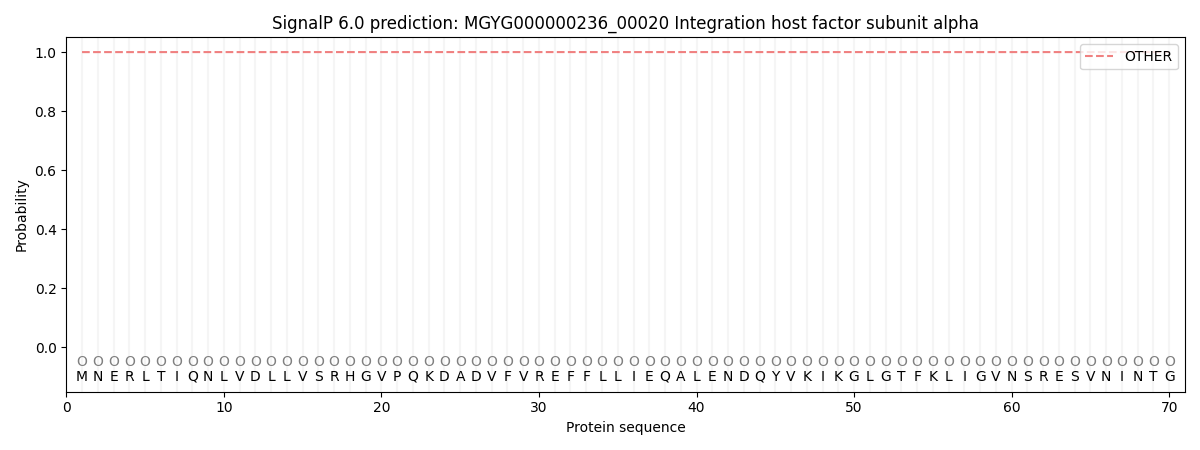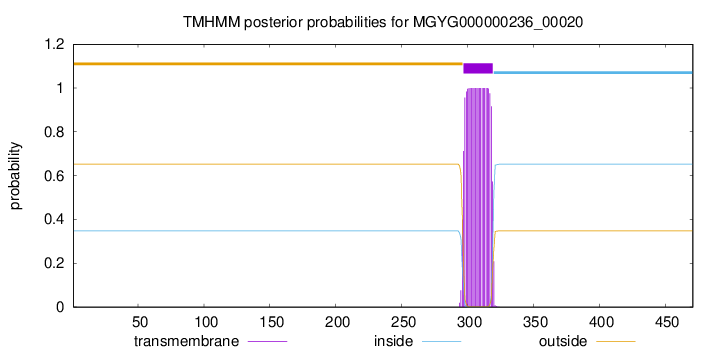You are browsing environment: HUMAN GUT
CAZyme Information: MGYG000000236_00020
You are here: Home > Sequence: MGYG000000236_00020
Basic Information |
Genomic context |
Full Sequence |
Enzyme annotations |
CAZy signature domains |
CDD domains |
CAZyme hits |
PDB hits |
Swiss-Prot hits |
SignalP and Lipop annotations |
TMHMM annotations
Basic Information help
| Species | Bacteroides fragilis_A | |||||||||||
|---|---|---|---|---|---|---|---|---|---|---|---|---|
| Lineage | Bacteria; Bacteroidota; Bacteroidia; Bacteroidales; Bacteroidaceae; Bacteroides; Bacteroides fragilis_A | |||||||||||
| CAZyme ID | MGYG000000236_00020 | |||||||||||
| CAZy Family | CBM50 | |||||||||||
| CAZyme Description | Integration host factor subunit alpha | |||||||||||
| CAZyme Property |
|
|||||||||||
| Genome Property |
|
|||||||||||
| Gene Location | Start: 23681; End: 25096 Strand: - | |||||||||||
CDD Domains download full data without filtering help
| Cdd ID | Domain | E-Value | qStart | qEnd | sStart | sEnd | Domain Description |
|---|---|---|---|---|---|---|---|
| pfam00216 | Bac_DNA_binding | 6.23e-16 | 10 | 93 | 5 | 88 | Bacterial DNA-binding protein. |
| cd13832 | IHF | 3.21e-12 | 10 | 91 | 4 | 85 | Integration host factor (IHF) and similar proteins. This subfamily includes integration host factor (IHF) and IHF-like domains. IHF is a nucleoid-associated protein (NAP) that binds and sharply bends many DNA targets in a sequence specific manner. It is a heterodimeric protein composed of two highly homologous subunits IHFA (IHF-alpha) and IHFB (IHF-beta). It is known to act as a transcription factor at many gene regulatory regions in E. coli. IHF is an essential cofactor in phage lambda site-specific recombination, having an architectural role during assembly of specialized nucleoprotein structures (snups). IHF is also involved in formation as well as maintenance of bacterial biofilms since it is found in complex with extracellular DNA (eDNA) within the extracellular polymeric substances (EPS) matrix of many biofilms. This subfamily also includes the protein Hbb from tick-borne spirochete Borrelia burgdorferi, responsible for causing Lyme disease in humans. Hbb, a homodimer, shows DNA sequence preferences that are related, yet distinct from those of IHF. |
| smart00411 | BHL | 3.99e-12 | 5 | 94 | 1 | 90 | bacterial (prokaryotic) histone like domain. |
| cd13835 | IHF_A | 9.16e-12 | 10 | 93 | 5 | 88 | Alpha subunit of integration host factor (IHFA). This subfamily consists of the alpha subunit of integration host factor (IHF) and IHF-like domains. IHF is a nucleoid-associated protein (NAP) that binds and sharply bends many DNA targets in a sequence specific manner. It is a heterodimeric protein composed of two highly homologous subunits IHFA (IHF-alpha) and IHFB (IHF-beta). It is known to act as a transcription factor at many gene regulatory regions in E. coli. IHF is an essential cofactor in phage lambda site-specific recombination, having an architectural role during assembly of specialized nucleoprotein structures (snups). IHF is also involved in formation as well as maintenance of bacterial biofilms since it is found in complex with extracellular DNA (eDNA) within the extracellular polymeric substances (EPS) matrix of many biofilms. |
| cd00591 | HU_IHF | 3.59e-11 | 8 | 91 | 2 | 85 | DNA sequence specific (IHF) and non-specific (HU) domains. This family includes integration host factor (IHF) and HU, also called type II DNA-binding proteins (DNABII), which are small dimeric proteins that specifically bind the DNA minor groove, inducing large bends in the DNA and serving as architectural factors in a variety of cellular processes such as recombination, initiation of replication/transcription and gene regulation. IHF binds DNA in a sequence specific manner while HU displays little or no sequence preference. IHF homologs are usually heterodimers, while HU homologs are typically homodimers (except HU heterodimers from E. coli and other enterobacteria). HU is highly basic and contributes to chromosomal compaction and maintenance of negative supercoiling, thus often referred to as histone-like protein. IHF is an essential cofactor in phage lambda site-specific recombination, having an architectural role during assembly of specialized nucleoprotein structures (snups). Bacillus phage SPO1-encoded transcription factor 1 (TF1) is another related type II DNA-binding protein. Like IHF, TF1 binds DNA specifically and bends DNA sharply. |
CAZyme Hits help
| Hit ID | E-Value | Query Start | Query End | Hit Start | Hit End |
|---|---|---|---|---|---|
| QCQ55328.1 | 0.0 | 1 | 471 | 1 | 471 |
| QRM71401.1 | 0.0 | 1 | 471 | 1 | 471 |
| QTO24926.1 | 0.0 | 1 | 471 | 1 | 471 |
| QCQ37580.1 | 2.71e-314 | 1 | 471 | 1 | 471 |
| QCQ50554.1 | 2.71e-314 | 1 | 471 | 1 | 471 |
Swiss-Prot Hits download full data without filtering help
| Hit ID | E-Value | Query Start | Query End | Hit Start | Hit End | Description |
|---|---|---|---|---|---|---|
| B4SQG8 | 4.75e-09 | 5 | 91 | 3 | 89 | Integration host factor subunit alpha OS=Stenotrophomonas maltophilia (strain R551-3) OX=391008 GN=ihfA PE=3 SV=1 |
| B2FN73 | 4.75e-09 | 5 | 91 | 3 | 89 | Integration host factor subunit alpha OS=Stenotrophomonas maltophilia (strain K279a) OX=522373 GN=ihfA PE=3 SV=1 |
| Q65TL4 | 6.32e-09 | 5 | 90 | 3 | 88 | Integration host factor subunit alpha OS=Mannheimia succiniciproducens (strain MBEL55E) OX=221988 GN=ihfA PE=3 SV=1 |
| Q2P101 | 8.86e-09 | 5 | 91 | 3 | 89 | Integration host factor subunit alpha OS=Xanthomonas oryzae pv. oryzae (strain MAFF 311018) OX=342109 GN=ihfA PE=3 SV=1 |
| P0A0U0 | 8.86e-09 | 5 | 91 | 3 | 89 | Integration host factor subunit alpha OS=Xanthomonas axonopodis pv. citri (strain 306) OX=190486 GN=ihfA PE=3 SV=1 |
SignalP and Lipop Annotations help
This protein is predicted as OTHER

| Other | SP_Sec_SPI | LIPO_Sec_SPII | TAT_Tat_SPI | TATLIP_Sec_SPII | PILIN_Sec_SPIII |
|---|---|---|---|---|---|
| 1.000057 | 0.000000 | 0.000000 | 0.000000 | 0.000000 | 0.000000 |

